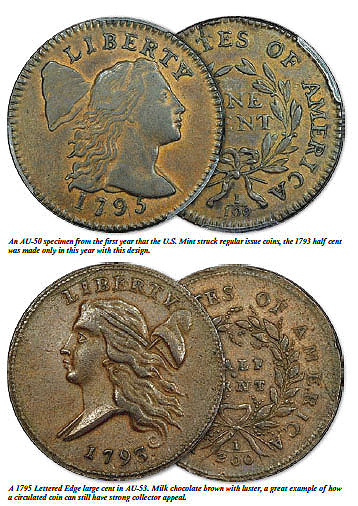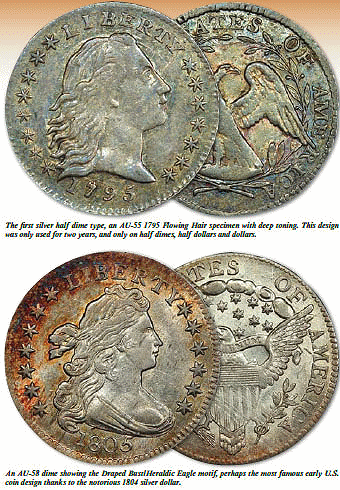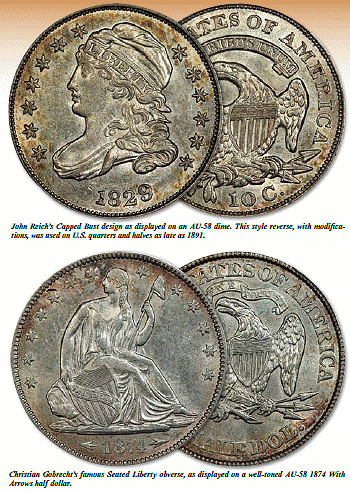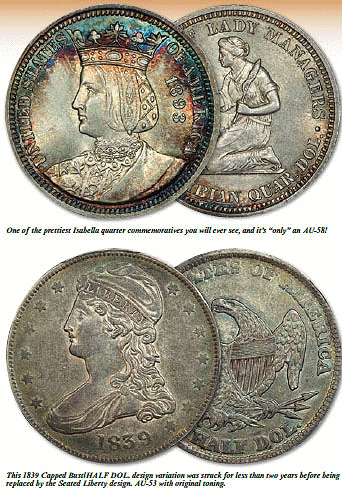by Tom DeLorey – Harlan J. Berk, Ltd. ……………
“Circulated Coins: The Perfect Alternative” was originally published in the February 2013 issue of COINage, Volume 49, Number 2. It is reprinted here with permission from the author.
Coin collecting today is obsessed with perfection. Perhaps it comes from the proliferation of newly struck non-circulating legal-tender (NCLT) bingles, with coins issued in capsules instead of rolls or bags. People who buy products from the U.S. Mint and send them to a third-party grading service are appalled if the items receive “only” a Proof- or Mint State-68 grade, instead of the sacred 70. Should the item be a bullion American Eagle or American Buffalo coin, it might end up in a dealer’s case along with other “common bullion.”
It was not always so. Long ago, people collected U.S. coins that had been made for commerce, and they put together sets of whatever quality they could afford to buy – if they couldn’t just find it in circulation at face value. The coins scarce enough to be handled by dealers were classified as “New” or “Used,” and priced accordingly. Naturally, the nicer “used” coins were priced slightly higher than the well-worn used coins, and eventually the modern grading system evolved to recognize and reflect the modern pricing reality.

An utterly gorgeous 1902 Barber half in AU-58 condition with nearly full luster, solid original toning and just a hint of rub on the neck, jaw, wing tips and tail feathers.
However, the great divide between “New” and “Used” never went away. “New” was always better, even if “New” meant a heavily bag-marked, unattractively toned, common-date New Orleans Mint Morgan silver dollar, flatly struck through a smattering of sawdust chips left over from the planchet preparation process – as opposed to a well-struck and lustrous but lightly “Used” San Francisco Mint silver dollar that got spent a few times before being retired into Great-Grandma’s silk “mad money” pouch, where it developed a colorful patina over its relatively few contact marks.
Ignore value. Which is the more desirable coin? Obviously it is the Choice About Uncirculated dollar, because it flat-out looks nicer than the ugly Unc! The same principle applies to other U.S. coins.
 That said, the reality is that with Morgan dollars, there are certain dates and mint marks that are available in huge quantities in uncirculated condition, and so AU Morgans as a class get no respect, except for those date-and-mint-mark combinations that were either entirely released into circulation shortly after striking or melted down for a British war loan in 1918. With but a handful of legitimately uncirculated 1893-S dollars known, an AU or even an Extremely Fine coin would be a joy to own.
That said, the reality is that with Morgan dollars, there are certain dates and mint marks that are available in huge quantities in uncirculated condition, and so AU Morgans as a class get no respect, except for those date-and-mint-mark combinations that were either entirely released into circulation shortly after striking or melted down for a British war loan in 1918. With but a handful of legitimately uncirculated 1893-S dollars known, an AU or even an Extremely Fine coin would be a joy to own.
Now let us consider another series – the Barber half dollar, which is more or less contemporary with the Morgan dollar. Unlike Morgans, Barber halves were not overproduced for political reasons and then stored in vaults for decades as backing for Silver Certificates, only to emerge into a 1960s world chock-full of collectors. Instead, they were struck to order for commerce – and if one year’s mintage did not get fully distributed by Dec. 31, it would almost certainly be released in the first few months of the next year.
Once released into circulation, coins circulated! The half dollar was a workhorse denomination back then – a significant store of value that was not deemed too heavy to carry in a pocket or coin purse, unlike the generally unpopular (except in the West) silver dollars. If you broke a paper dollar at a store for a small purchase, there was an excellent chance that you would get a half dollar back in your change. Later, you would spend it to buy something else. This held true for the half dollar denomination until 1964.
Within a week after being first spent, an “uncirculated” coin would become noticeably “About Uncirculated,” and within a month it could become Extremely Fine unless it got diverted into a piggy bank, dresser drawer or some other holding cell. I suspect that a coin could lose enough luster and fine detail to be merely Very Fine within a mere 12 months of active circulation, after which the loss of grade level would slow to a crawl as the main design fended off contact after contact, as it was intended to do.
(Back when I taught grading seminars for the American Numismatic Association, I used to suggest that as an exercise, the students take a common BU 1964 Washington quarter and carry it in their pocket change for a year – being careful not to spend it, of course. I told them to take a look at it with their grading glass every night, and to watch as wear appeared and luster disappeared. This is still a useful educational exercise, and with silver prices what they are, the coin at the end of the year will be barely, if at all, worth less than if it were still uncirculated.)
 Uncirculated Barber halves are legitimately rare. A handful of active collectors at the time, such as the second-generation owner of the three-generation Emery-Nichols Collection (sold by Bowers & Merena in 1984; see that firm’s catalog), routinely obtained choice uncirculated coins directly from the different mints each year, and a few of the larger dealers no doubt put away a few of each for their customers, but they were probably never saved in BU roll quantities, and certainly never bags.
Uncirculated Barber halves are legitimately rare. A handful of active collectors at the time, such as the second-generation owner of the three-generation Emery-Nichols Collection (sold by Bowers & Merena in 1984; see that firm’s catalog), routinely obtained choice uncirculated coins directly from the different mints each year, and a few of the larger dealers no doubt put away a few of each for their customers, but they were probably never saved in BU roll quantities, and certainly never bags.
Natural exceptions would have been the first date of the series, 1892, and the last, 1915. Many people – collectors and non-collectors alike – put away an example of any new coin design just because they have never seen one before, though such souvenirs are often lightly circulated because non-collectors did not care enough to bother getting new ones at a bank. Coins of the last year or two of a popular series, such as the Indian cent, might be put away just because “they aren’t making these anymore,” though the popularity of the Barber half in its day is questionable.
This phenomenon is great for the type collector, but what of the date collector? After the novelty of the new design wore off, the average citizen was less likely to save an uncirculated 1895-S coin, or an 1897-O, with most collectors scattered across the East Coast and Midwest, where Philadelphia Mint coins were distributed. Collecting by mint mark did become more common after Augustus G. Heaton published A Treatise on Coinage of the United States Branch Mints in 1893, which might have inspired the Emery-Nichols collection mentioned previously.
(I saw that collection intact in upstate New York back in 1983. The gem uncirculated branch-mint coins, plus Philadelphia Mint proofs, started in 1895, the earlier-date coins having been largely pulled from circulation. However, such collector diligence was rare, and many series are virtually impossible to complete in true uncirculated condition.)
So why not collect nice circulated coins? It can be no less challenging, even if less expensive. When I worked for Harlan J. Berk Ltd. In Chicago, we had one collector who commissioned us to put together for him complete sets of Barber dimes, quarters and halves in problem-free Very Fine condition. We counseled patience, and after five years I had filled perhaps two-thirds of the holes in his albums. An Extremely Fine Barber set of all three denominations would be a magnificent achievement, and even just the dime set (without the 1894-S, of course!) would be a noble effort.
 (I once worked with a man, James G. Johnson, who collected only circulated coins, and he did put together a complete set of Barber dimes, including the 1894-S. It was in only Good condition, as was much of the rest of the set, but it probably qualified him for the best-darned circulated set of Barber dimes ever assembled!)
(I once worked with a man, James G. Johnson, who collected only circulated coins, and he did put together a complete set of Barber dimes, including the 1894-S. It was in only Good condition, as was much of the rest of the set, but it probably qualified him for the best-darned circulated set of Barber dimes ever assembled!)
Other sets can be completed in Extremely Fine to About Uncirculated condition with less difficulty. A well-matched EF-AU “wheatback” Lincoln cent set (1909-1958) would be doable, the hardest ones probably being the 1914-D and the 1922 “no-D.” This is because the 1914-D was struck well after the novelty of the series had worn off, and few of them were set aside by collectors until “penny board” albums became popular in the 1930s.
Though these boards do get the credit for saving many 1914-D cents and other key-date coins from simply wearing out and being lost to the hobby forever, the early dates in the Lincoln series had 20 to 25 years’ wear on them before the boards appeared. The 1922 “no-D” cents are tough in high grade because they were so poorly made to begin with, and collectors trying to fill a 1922-D hole in a board would probably have rejected them as unworthy. After all, they didn’t even show a mint mark! (The same phenomenon might have caused 1937-D “three-legged” Buffalo nickels to remain in circulation later than they otherwise might have been saved, because the coins looked too moth-eaten to be worth collecting even when new.)
I suggested doing just the wheatback cents in EF to AU because the 1959-2008 Lincoln Memorial cents (and the later issues) are too easy to collect in uncirculated condition to bother with circulated coins. That said, it might be harder to complete a well-matched EF to AU 1959-to-date set, simply because most of the coins are worth only face value, and no dealer would bother to stock them.
You would have to do it the old-fashioned way: getting rolls of coins at the bank and searching through them. Finding well-matched coins would be difficult because many modern cents do not circulate long enough to get both worn and toned down to a nice EF-AU, instead acquiring just a few random finger marks and scratches before being unceremoniously dumped into a container somewhere.
 A nice EF-AU Buffalo nickel set would be challenging but doable, as would the contemporary “Mercury” dime, Standing Liberty quarter and Walking Liberty half dollar series. Again there are key dates that will make you gulp before you pull the trigger on them, but the uncirculated specimens of those dates are even pricier. Any one of them would be impressive – especially the quarter set, because its first-year coin was issued in very limited quantities (52,000 pieces) and released too late in 1916 to attract much notice.
A nice EF-AU Buffalo nickel set would be challenging but doable, as would the contemporary “Mercury” dime, Standing Liberty quarter and Walking Liberty half dollar series. Again there are key dates that will make you gulp before you pull the trigger on them, but the uncirculated specimens of those dates are even pricier. Any one of them would be impressive – especially the quarter set, because its first-year coin was issued in very limited quantities (52,000 pieces) and released too late in 1916 to attract much notice.
If collecting a date-and-mint-mark set in EF to AU is still too daunting, how about collecting a nice type set in attractive, high-grade circulated condition? Recently, Berk’s acquired and offered for sale a nearly complete non-gold U.S. type set, with many of the types in “only” AU. But what AU’s!
The 1793 half cent, a one-year type coin, was graded by two third-party services as AU-50 Brown (BN). A 1795 Liberty Cap cent with Lettered Edge was double-graded AU-53 BN. A 1795 Flowing Hair half dime was graded AU-55, followed by a 1797 Draped Bust, Small Eagle half dime in AU-53 and an 1800 Draped Bust, Heraldic Eagle half dime in AU-55. The collection went on through other early types in similar style.
Yes, the coins were circulated – but they were still attractive and desirable. When I heard the collection was coming in, I went back to the store to look at it before the coins went on sale, because I knew the quality that the collector liked, having sold him a few pieces over the years. It was a joy to behold, and it was good that I did so, as some 75 percent of the collection found new homes within three days of its going online.
Nice circulated coins will always be collected by intelligent collectors, because there will always be a demand for them. It is better to own a nice, circulated coin than none at all. Not everybody has an unlimited checkbook to buy only perfect coins, nor the narrow-minded attitude to insist on them.
I have told the story here before about once having an AU-55 Turban Head gold eagle in inventory at a coin show, only to have someone sneer at it because it “wasn’t uncirculated.” That man was a fool. The coin was beautiful, over two centuries old and could have been circulated by Thomas Jefferson (or Aaron Burr!).
Give circulated coins a try. One final advantage they enjoy is that often they need not be “slabbed” before you buy them. And you can actually touch them (by the edge, of course) as you admire their beauty, and think about the fellow collectors who have touched them before.
This article , written by Tom DeLorey, was inspired by a beautiful collection of United States Type coins recently acquired by Harlan J. Berk, Ltd. Tom, who retired at the end of 2010 after working for Berk for over 20 years, assisted in the attribution and had the pleasure of viewing the entire collection od U.S. Coins before it was offered for sale. The collection was assembled by a long time, seasoned collector over the course of decades and finished in the late 1980’s as “slabbing” was coming into vogue. Lacking only the Chain and Wreath Cents and 1796 Quarter, the collection was XF-AU with an occasional BU piece.
About Harlan J. Berk, Ltd.
Since 1964, Harlan J. Berk, Ltd. has been the leader in ancient coins. When they took over their premier location in the heart of Chicago’s financial district in 1988, they expanded the business to include the full spectrum of United States coinage. Today, they handle nice collector coins as well as some of the finest known rarities. You can visit Harlan J. Berk, Ltd. online at http://hjbltd.com/unitedstatesco/cnus.asp. If you’d like to see the online catalog for the Broward County Type Set, which has now been sold, you can visit here http://issuu.com/hjb-ancientcoins/docs/hjb_the_broward_county_type_set. If you have any questions, please contact Mike Printz at [email protected] or David Greenstein at [email protected] or call 312.609.0016.




